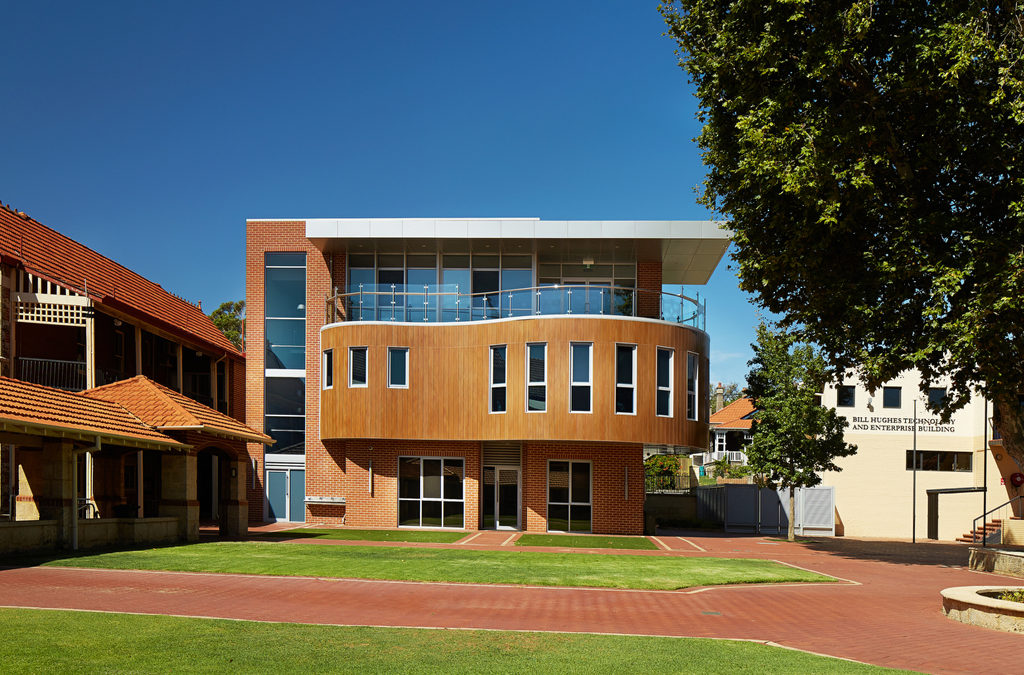A few years ago, on my first visit to Australia, I attended a conference on the spatial design of learning environments. During one of the presentations on new generation learning spaces, a teacher asked the presenter who had just shown their case study on a classroom of the future, “Why aren’t these new spaces designed with the user in mind?
What was your approach? Is it based on assumptions or teacher instructional practice?” These questions resonate with me and this is why we need to craft schools from an Evidence Based Design (EBD) approach; for, this approach addresses these questions and probes deeper to understand how individuals learn in their spaces.
EBD teaches us that the building alone will not encourage development, because, generally, they have been designed to impress, rather than support the purpose of the place. However, when crafted around pedagogy, the built environment has positive impacts on the learning environment. To this end, theory and research in educational, developmental, and environmental psychology and spatial design, must be examined thoroughly to create activity based learning environments that encourage learning and engage learners.
Therefore, first and foremost, the social environment must be evaluated; for, it is only by understanding peoples’ interactions can spaces be designed thoughtfully and responsibly. By knowing the pedagogy of the place, settings can be constructed to support the learner, the learning, and the things to be learned. The goal of this article is to introduce the reader to some of the qualities that underpin the creation of supportive learning environments, and examine various interior building features that extend these concepts. The features that will be examined are:
- The Breakout Node
- Sliding Cavity Doors
- Vertical Writing Surfaces
Qualities of a supportive environment
A supportive environment begins and ends with caring adults; for, they are available to the learner every day, in all ways, and in times of need. Creating a stable and dependable environment affords the learner the capacity to develop positive attachments with others. Learners who have developed stable human attachments are best able to explore independently, identify potential stressful situations, and determine how to resolve them. Therefore, supportive social environments afford the learner the confidence to take risks and learn resiliency.
By developing confidence, resiliency, and positive attachments, learners can acquire identities of themselves. Self-Identity emerges from a variety of inputs, including social interactions. These interactions transform the learner and impact their self-concept. Acquiring an identify provides the learner with the spring board and foundation on which to appropriate higher order executive functions critical for educational success such as concept development, hypotheses testing, and problem solving. As learners acquire identities of themselves, they are also realizing the emerging identities of their peers. Hence, the development of self-awareness and social awareness is a direct result of individuals participating in activities with others and in environments—built, natural, and otherwise.
The social exchanges occur as a result of situations which generate a shared set of ideas about place. This shared set of ideas about place may be described as place-identity. Place-identity is the individual’s incorporation of place into the larger concept of self. While learners see themselves distinct from, yet related to the built environment, they are rooted in the experiences they have in the built environment working with the resources that actuate learning and influence their interactions.
A supportive environment where learners not only develop awareness of themselves and others, but also their surroundings, may be described as active learning environments. Moreover, active learning environments, support a growth mindset, which is a perspective that views all situations as learning opportunities and where intelligence is achieved through hard work. Accepting that hard work leads development is a shift in how learning is conceived. Learning is not merely occurring through discovery, but rather is transformative (Lippman, 2013). Hence, a learning environment that is viewed as transformative recognizes that the learner influences their social and physical environments, and these environments, in turn, also shape them.
Features of the built environment that afford a supportive learning environment
Broadening this perspective, an Evidence Based Design approach considers the features of the built environment that afford the social aspects of a supportive learning environment. These include clear site lines through the spaces, areas of prospect and refuge, areas that the individual can shape to feel safe and secure, and spaces, within as well as outside classrooms where the learner can meet with peers and adults to work through their projects. To afford these interactions, the environment must be as Montessori termed prepared. Within the prepared environment learners feel well emotionally and are not distracted, since these places provide distinct learning areas which clearly inform the learners of the activities and actions which can occur in them. Therefore, a successful learning environment must be structured with a variety of defined breakout spaces outside classrooms and activity settings in classrooms.
The Breakout Node
A node may be defined as a confluence in a network at which pathways intersect or branch. For a learning environment, the node is the heart of the building. Since this is also a place that affords informal, formal and creative learning to extend beyond the classrooms, it is a breakout space. Hence, the heart of a school may be termed a breakout node. The breakout node is a place in the school that encourages the development of positive attachments, identity, and reduces stress. The reason for this is that the node is an intersection where students can gather. When learners gather, they share knowledge. This sharing of knowledge shapes individuals’ identities of themselves and one another. Based on my research, these places can also empower learners; for, they can take ownership of the breakout node. Ownership takes place when learners organize work areas within it to support how they choose to work with others and/or independently).
In a school setting, the breakout node may take the form of a stair with amphitheater seating or a place that has a variety of defined breakout spaces. In this case, breakout spaces refer to activity zones outside, adjacent, and specific to each classroom. While the amphitheater seating provides places for a variety of diverse groupings to come together, sit, stand, and/or lay their wares, the defining quality of the breakout node are the areas around it. It is these learning zones that contribute to the vibrancy of the learning environment, i.e. the amphitheater seating affords breakout areas/niches along its sides and under it. These activity zones are place that afford opportunities for small groupings and/or independent work to occur. Moreover, these breakout niches also are places of prospect and refuge that learners shape for comfort, security and safety.
Cavity Sliding Doors
Complementing the breakout node and breakout niches are cavity sliding doors (Fig. 3). This type of door system refers to the cavity (including track & carriages) which is installed within the wall framing and allows a door to slide inside it. Cavity sliders connect spaces. On projects that I have completed in Australia, breakout spaces specific to each classroom were created. When the cavity sliders are closed, the classroom and breakout spaces operate as separate learning zones; however, when the sliding doors are open, the spaces are joined. This extends the classroom by affording an additional area for cooperative project-based group work to occur.
In classrooms, the walls that conceal the doors create activity settings. The reason for this is the walls of cavity sliders form a junction with a wall perpendicular with it. This junction forms a corner activity setting. Corners define settings that allow learners a place of prospect and refuge where they can work without distractions. Whether the doors are open or closed the corner activity settings remain undisturbed. As my research has indicated, cavity sliding doors integrate spaces, and provide identifiable activity settings and breakout spaces where learners can work through the projects-at-hand.
Vertical Writing Surfaces
School buildings have historically been designed with classrooms where learners are corralled away from walls. Within these teacher-centered environments, students sit at desks which are placed in rows facing a chalkboard, whiteboard, TV, and/or smart board. However, in a learner-centered environment, the shift must be to create activity settings. Activity settings are learning zones within classrooms (or rooms within rooms). Generally, the approach I have used is to consider six activity settings in a classroom, where students can work independently and/or in small groups engaged in solving problems. Given this, each activity setting must be provided with vertical display surfaces on which to write the learnings from the class period and/or day.
My research indicates that rather than installing whiteboards horizontally, approximately 900 mm above the finished floor, whiteboards should be installed vertically, 100mm above the finished floor and minimally in pairs. This provides cues and defines an area of 2400mm x 2400mm where learners know where to work, and affords people of all heights to comfortably access and share information. Furthermore, it provides additional focal points where information can be posted and encourages learners to communicate and work collaboratively within, across, and between small social groupings. The inclusion of vertical writing surfaces must not merely be confined to classrooms, but also must be considered in the breakout spaces outside and adjacent to classrooms. Hence, the corridor can become a place that reinforce the notion and symbolize that learning is fluid and can occur in any place and at any time.
Conclusion
Preparing the environment to be supportive with defined breakout spaces and activity settings is essential for creating future leaning environments. This spatial design approach resulting from EBD is a paradigm shift to integrated learning environments. To craft an integrated environment requires a re imagining of what instagram viewer flowing, fluid and flexible means. It does not mean having large open common spaces that occur between classrooms where this open space is stocked with movable furniture, but rather means crafting spaces designed for the intended transactions that support the social and emotional development of the learner. Whereas breakout node helps to distinguish spaces where learner can work with fewer distractions, cavity sliding doors connect learners to one another and vertical writing surfaces focus learning to tasks in a specific area.
By following an EBD approach, learning environments of the future will be grounded in an understanding of the activity, motivations, and operations of the learner. This paradigm shift in the spatial design begins with and focuses on interactivity. Given this, it is essential for the learning community to articulate what their vision is for each space, how it will be used and what activities are intended to occur in them. From this, the appropriate features programmed, planned and designed to support the intended interactions. Since the spatial design will be guided by the socio-psychological, the result will lead to a more integrated, open, and personalized learning environment.
This article was first published at: british-gypsum.com/evidence-space/learn/spatial-design-of-learning-environments
References
Lippman, P. C. (2013). Guiding the Design Process: The Holy Cross College Early Learning Center in Perth (Part II). https://holtthink.tumblr.com/post/81545778780/guiding-the-design-process-the-holy-cross-college.


Recent Comments